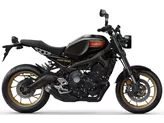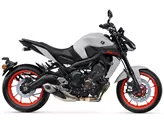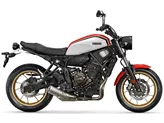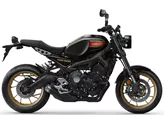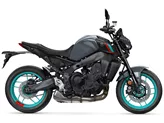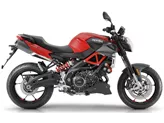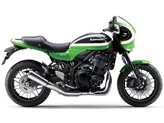Suzuki GSR 750 2013 vs. Yamaha XSR900 2018

Suzuki GSR 750 2013

Yamaha XSR900 2018
Vue d’ensemble - Suzuki GSR 750 2013 vs Yamaha XSR900 2018
The Suzuki GSR 750 2013 and the Yamaha XSR900 2018 are both naked bikes with similar engine types, in-line configurations. However, there are several differences between the two models in terms of engine power, torque, cylinders, displacement, frame, weight, and fuel tank capacity.
In terms of engine power, the Yamaha XSR900 2018 has a slight advantage with 115 HP compared to the Suzuki GSR 750 2013's 106 HP. The Yamaha also has a higher torque of 87.5 Nm compared to the Suzuki's 80 Nm. Additionally, the Yamaha has three cylinders while the Suzuki has four, and the Yamaha has a larger displacement of 847 ccm compared to the Suzuki's 749 ccm.
In terms of chassis, the Suzuki GSR 750 2013 has a steel frame, while the Yamaha XSR900 2018 has an aluminum frame. Both models have a twin tube frame type. The Yamaha's aluminum frame may contribute to its lighter weight, as it weighs 188 kg compared to the Suzuki's 211 kg.

Suzuki GSR 750 2013
Both models have double disk brakes at the front, providing good stopping power. They also have the same tire dimensions, with a front tire width of 120 mm and a rear tire width of 180 mm, both with a diameter of 17 inches.
In terms of dimensions and weights, the Yamaha XSR900 2018 has a slightly shorter wheelbase of 1440 mm compared to the Suzuki GSR 750 2013's 1450 mm. Both models have the same seat height of 815 mm. The Yamaha is lighter with a kerb weight of 188 kg compared to the Suzuki's 211 kg. However, the Suzuki has a larger fuel tank capacity of 17.5 liters compared to the Yamaha's 14 liters.

Yamaha XSR900 2018
In terms of strengths, the Suzuki GSR 750 2013 offers good ergonomics, a powerful engine, ABS, and instruments that are easy to read. On the other hand, the Yamaha XSR900 2018 has an extremely sporty and rev-happy engine, excellent brakes, a pleasant seating position, high-quality workmanship, and a good price-performance ratio.
In terms of weaknesses, the Suzuki GSR 750 2013 has weak brakes, a cheap-looking square swingarm, and suspension elements without adjustability. The Yamaha XSR900 2018, on the other hand, has an almost too direct response and a retro style that may not be thought through to the last detail.
Overall, both models have their strengths and weaknesses, and the choice between them will depend on the rider's preferences and priorities. The Yamaha XSR900 2018 may appeal to riders looking for a more sporty and rev-happy engine, excellent brakes, and a good price-performance ratio. On the other hand, the Suzuki GSR 750 2013 may be a better choice for riders looking for good ergonomics, a powerful engine, and ABS.
Caractéristiques techniques Suzuki GSR 750 2013 par rapport à Yamaha XSR900 2018
Avantages et inconvénients en comparaison
Avantages et inconvénients en comparaison
Suzuki GSR 750 2013

En raison du manque de possibilités de réglage, la suspension est un bon compromis.
Yamaha XSR900 2018

La Yamaha XSR900 est une illusion d'optique classique - avec son phare rond, son réservoir anguleux et son feu arrière rapporté, elle passe clairement pour une moto rétro. Mais ce n'est pas un hasard si ses performances rappellent celles de la puissante moto tout terrain de classe moyenne Yamaha MT-09, car celle-ci constitue la base extrêmement sportive de la XSR900. Le moteur est donc une merveille et les freins sont très puissants. En ce qui concerne le châssis, les techniciens n'exagèrent heureusement pas, la XSR900 offre suffisamment de confort et la position d'assise droite est plus confortable que ne le laisserait supposer le moteur puissant. Dans la catégorie des motos rétro, la XSR900 est néanmoins l'un des modèles les plus sportifs.
Comparaison des prix Prix moyen du marché Suzuki GSR 750 vs Yamaha XSR900
There are a few key differences between a Suzuki GSR 750 2013 and a Yamaha XSR900 2018. In terms of price, the actual average price of a Yamaha XSR900 2018 is about 25% higher. A Suzuki GSR 750 2013 experiences a loss of 800 USD in one year and 920 USD in two years of ownership. This is offset by a loss of 180 USD and 120 USD for a Yamaha XSR900 2018. Compared to Yamaha XSR900 2018 there are more Suzuki GSR 750 2013 bikes available on the 1000PS.de Marketplace, specifically 10 compared to 4. It takes less time to sell a Suzuki GSR 750 with 58 days compared to 123 days for a Yamaha XSR900. Since model year 2011 1000PS.de editors have written 12 reviews for the Suzuki GSR 750 and 30 reviews for the Yamaha XSR900 since model year 2016. The first review for the Suzuki GSR 750 was published on 10/5/2010 and now has more than 5,400 views. This compares to more than 17,600 views for the first review on Yamaha XSR900 published on 11/25/2015.



